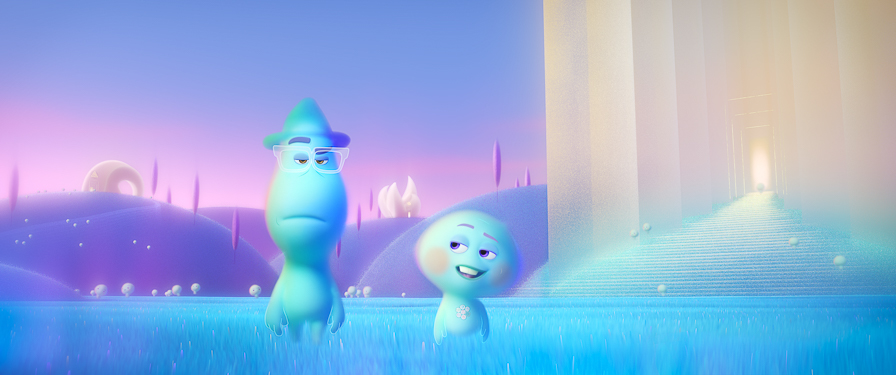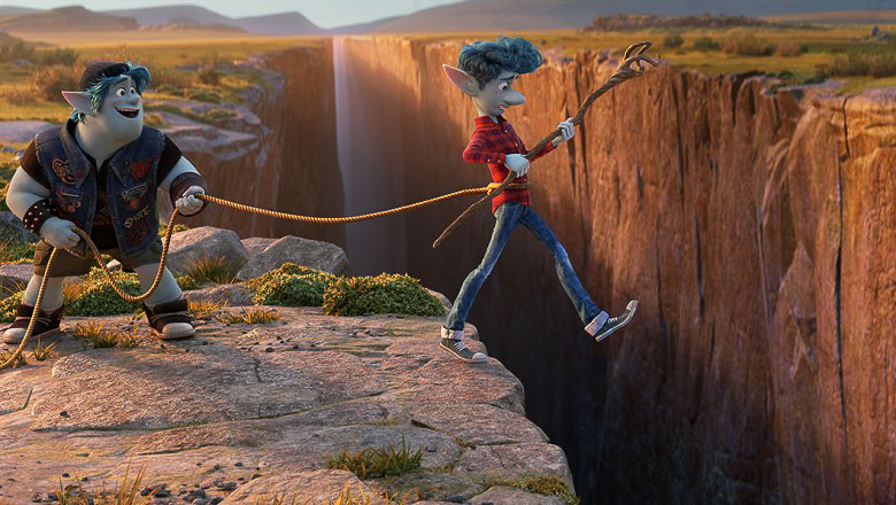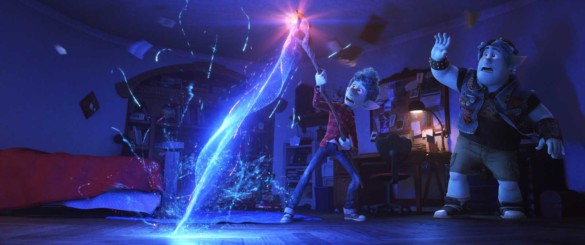By Greta Chiocchetti
Shaun Chacko remembers being enchanted by classic Disney animations like “The Lion King” and “Aladdin” as a kid. Though he wasn’t yet familiar with the technical workings of the movie magic he saw onscreen, Chacko always wanted to be a part of it.
“I was always really into art class and drawing as a kid. In my culture—I have a South Indian background—animation wasn’t a popular career path, and my parents, of course, wanted me to be a doctor,” said Chacko, laughing. “It wasn’t until high school that I got really into animation and started to think really seriously about doing it in my future. Luckily, my parents encouraged me to try it out and see, and it turned out to be it for me.”
Today, it’s safe to say that Chacko has indulged his creative side and reaped the benefits. Chacko, a character animator at Pixar, has worked on some of the studio’s most beloved and awarded pictures, beginning with “Ratatouille,” which won an Oscar in 2007, and most recently, “Soul,” which prevailed at the Oscars and the Annie Awards earlier this year. Chacko was nominated at the Annies for Best Character Animation for his work on “Onward,” which also received a nomination at this year’s Oscars.
Currently, Chacko teaches Feature Animation Training classes at Academy of Art University, where he passes on his years of industry experience to students in the School of Animation & Visual Effects. In an interview with Art U News, Chacko shares his path into the world of animation and provides valuable insight for current students looking for their big break.
How did you land your job at Pixar?
Part luck and part determination. A couple of friends I worked with at Chuck Gammage Animation, a commercial studio in Toronto, Canada, had friends who worked at Pixar. It’s sometimes tough to see online postings for jobs at Pixar, [because], like a lot of companies, they tend to look internally to try to fill a role. The guys at Pixar reached out to my friends in Toronto and asked if they knew anyone, and my friends told me about the opening. They told me they needed a reel, so I worked really hard on a 10-second animation test. At Pixar, they want to see really good acting and ideas beyond your technical ability. So, I worked my butt off on a clip from “On the Waterfront”—I animated a character to one of Marlon Brando’s lines. And they liked it—they asked me to come in for an interview.

What do you do as a character animator?
As a character animator, I’m given scenes from the film, and my job is basically to bring the characters to life. You can think of the characters as computer-generated puppets, just sitting there waiting to be moved. We will have the storyboards and the director’s vision to work from, as well as the character actor’s voiceover, but we need to bring our own performance to the scene. We’re acting, but we’re doing it through a computer. Sometimes, to help us figure out the performance, we act out our scenes in front of a camera or mirror and just really take note of what our bodies are doing and what our expressions are.
In “Onward,” I animated the scenes after Ian had made it across the bottomless pit, realizing the rope had not been tied around him the whole time. That was a really fun sequence because it had some strong emotions with a bit of humor mixed in. There’s a line where Ian, still freaked out, asks Barley, “How long was the rope gone?” and Barley casually says, “Oh, just like…the second half of it,” and there are so many ways to play it. I think I tried like three or four different ways. I really wanted that moment to get a laugh, so I played around with the best way to get there. So, even though there is a clear goal for the shots we animate, we have to try to reach that goal in the most entertaining way possible, which takes some exploration.
How did you become part of the Feature Animation Training classes at the Academy?
The Academy has had a lot of Pixar animators teaching there, and I was a part of this group that felt like we were so lucky to be able to learn from people in the industry and wanted to give back to the next generation. Some of my colleagues at Pixar got in touch with the animation department at the Academy. We got together and thought of a curriculum that would supplement what the existing animation curriculum had—really focusing on feature animation because animation is so broad. There are all types of styles within animation that you can pursue—game animation, or more limited [and] cartoony styles. But we really wanted to focus on what it takes to be a feature animator, specifically at studios like Pixar, Disney, Sony, or DreamWorks.
It is awesome to be able to share what we know with the students. [A]lso, when you teach something, you internalize it more because you’re putting into words what you actually do every day. So, I think it made us all better animators as well.
Who should take the Feature Animation Training classes? What subject matter do they cover?
There are three levels to those classes. Feature Animation 1 is more for students that are pretty new to animation; they know the basics of Maya (industry-standard animation software), and they want to just focus on the physics aspect of animation. So, we start with fundamentals, like animating a bouncing ball and the basics of a walk cycle. And these are kind of the building blocks of all animation really because, to be a really good animator, you have to know physics. It also helps if students have an interest in art and design because in animation, you’re designing poses, and you’re designing facial expressions. So, we try to teach those things early on.
When you get into Feature Animation 2, it’s a little more complex—more complex physics, like running and jumping or lifting a heavy weight, and it starts to ramp up pretty quickly. But, I think we try to give a lot of assignments, so students can put these things into practice and just build on their knowledge. [T]hen, by the time they get into the third class—Feature Animation 3—that’s when we really get into the acting. So, the idea there is they have all the tools that they need to make a character move. If it’s an action shot, they know how to make a character move dynamically. But, we want students to put everything they’ve learned into a performance and really focus on emotion and [the] thought process.
I’ve been teaching Feature Animation 3 for about five years with Mark Harris, who’s an Academy alumnus. I think students really, really benefit from the class because if you’re an animator that knows timing and spacing, physics, how to create appealing poses and expressions, and [how to] show thought process, you can make anything come to life and give a convincing, entertaining performance. We’re really tough teachers because our goal is to grade them on a feature level, so they’re going to get a little bit more of a challenge. I’ve seen students just completely transform and get so much out of the class, so it’s really rewarding.

You’ve worked on several projects that have been nominated for awards, and many of them have won. What does it feel like to be recognized in that way?
It’s such a huge honor every time. Our goal is to entertain and have an impact on our audience, so for the studio to be recognized for both “Onward” and “Soul” this year was incredible. Every time, it really reminds me that I’m part of this studio that really cares about what they do.
And, you know, it’s a lot of work—animators spend about a year on each film. So for that to be recognized, for all that work to be recognized, is an awesome feeling for sure.
Both “Onward” and “Soul” have themes surrounding life and mortality and were released last year, a time where, unfortunately, we’ve been reckoning with a huge loss of life. What does it mean for Pixar to take on these huge themes in media that’s primarily seen as being for children?
I think we’ve always tried to make our films not just for kids, but for everyone. Of course, because it’s animated, generally people assume that it’s for kids, and we definitely have to make it age-appropriate, but that doesn’t necessarily have to be limiting. There’s always an element of our films that only the adults understand—and I think that’s really cool. The films tend to work in a range, too; for example, “Soul” is definitely targeted at a slightly older audience. But either way, our goal is to make a film that you can enjoy at any age. People of all ages respond to not only just appealing art but also the universal emotions and feelings that are just part of what it means to be human.
What advice would you give current students hoping to break into the industry?
First of all, watch a ton of animated films that inspire you. Obviously, a huge part of what we do is visual. So, by watching a lot of films, we’re just training our eyes and brains to recognize what good animation looks like. So, digest and analyze as much as you can. And then put it into practice—draw as much as you can and animate your own character test shots, either as a pantomime or using a piece of dialog from a film.
Becoming a feature animator takes a ton of work and dedication and requires very specific skills. So, if you’re taking any Academy animation course, don’t just take it to complete it. Take it to get the absolute most out of it that you can. Ask a lot of questions and put 110% into every assignment. Remember that your instructors know what it takes to be in the industry and want to help you get there.
